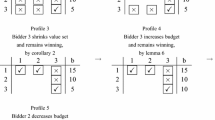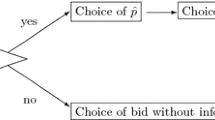Abstract
The present note analyzes the simultaneous ascending-bid auction with arbitrarily many asymmetric bidders with decreasing marginal valuations under complete information. We show that the game is solvable by iterated elimination of weakly dominated strategies if the efficient allocation assigns at least one unit to every player and if bid increments are sufficiently small. In that unique equilibrium, bidders immediately reduce their demand to the efficient allocation, and the auction ends in the first round of bidding.
Similar content being viewed by others
References
Ausubel, L., Schwartz, J.: The ascending auction paradox. Working Paper, University of Maryland (1999)
Ausubel L., Milgrom P. (2002). Ascending auctions with package bidding. In: Frontiers of theoretical economics, Vol 1. Berkely Economic Press, Berkely, CA, pp. 1–42
Ausubel, L., Cramton, P.: Demand reduction and inefficiency in multi-unit auctions. Working Paper, University of Maryland (2002)
Back K., Zender J. (1993). Auctions of divisible goods. Rev Financ Stud 6:733–764
Brusco S., Lopomo G. (2002). Collusion via signalling in open ascending auctions with multiple objects and complementarities. Rev Econ Stud 69:1–30
Chatterjee J., Samuelson L. (1990). Perfect equilibria in simultaneous offers bargaining. Int J Game Theory 19:237–267
Cramton P. (2005). Simultaneous ascending auctions combinatorial auctions. In: Cramton P., Shoham Y., Steinberg R (eds). Combinatorial auctions, Ch. 4. MIT Press, Cambridge
Engelbrecht-Wiggans, R., Kahn, C.: Low revenue equilibria insimultaneous auctions. Working Paper, University of Illinois (1998)
Grimm V., Riedel F., Wolfstetter E. (2003). Low price equilibrium in multi-unit auctions: the GSM spectrum auction in Germany. Int J Ind Organ 21(10):1557–1569
Menezes F.M. (1996). Multiple-unit English auctions. Eur J Polit Econ 12:671–684
Milgrom P. (2000). Putting auction theory to work: the simultaneous ascending auction. J Polit Econ 108:245–272
Milgrom P. (2004). Putting auction theory to work. Cambridge University Press, Cambridge
Rubinstein A. (1982). Perfect equilibrium in a bargaining model. Econometrica 50(1):97–109
Ståhl I. (1972). Bargaining theory. EFI The Economic Research Institute, Stockholm
Weber R.J. (1997). Making more from less: strategic demand reduction in the FCC spectrum auctions. J Econ Manage Strategy 6:529–548
Wilson R. (1979). Auctions of shares. Q J Econ 93:675–689
Author information
Authors and Affiliations
Corresponding author
Additional information
We would like to thank seminar participants at UC Davis, in particular Klaus Nehring and Louis Makowski for comments. Financial support by the Alexander–von–Humboldt Foundation through a Feodor–Lynen grant and by the Deutsche Forschungsgemeinschaft, SFB Transregio 15, “Governance and Efficiency of Economic Systems” is gratefully acknowledged.
Rights and permissions
About this article
Cite this article
Riedel, F., Wolfstetter, E. Immediate demand reduction in simultaneous ascending-bid auctions: a uniqueness result. Economic Theory 29, 721–726 (2006). https://doi.org/10.1007/s00199-005-0039-5
Received:
Accepted:
Published:
Issue Date:
DOI: https://doi.org/10.1007/s00199-005-0039-5




